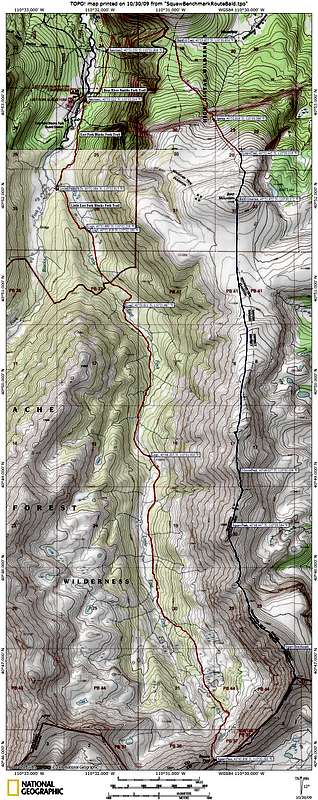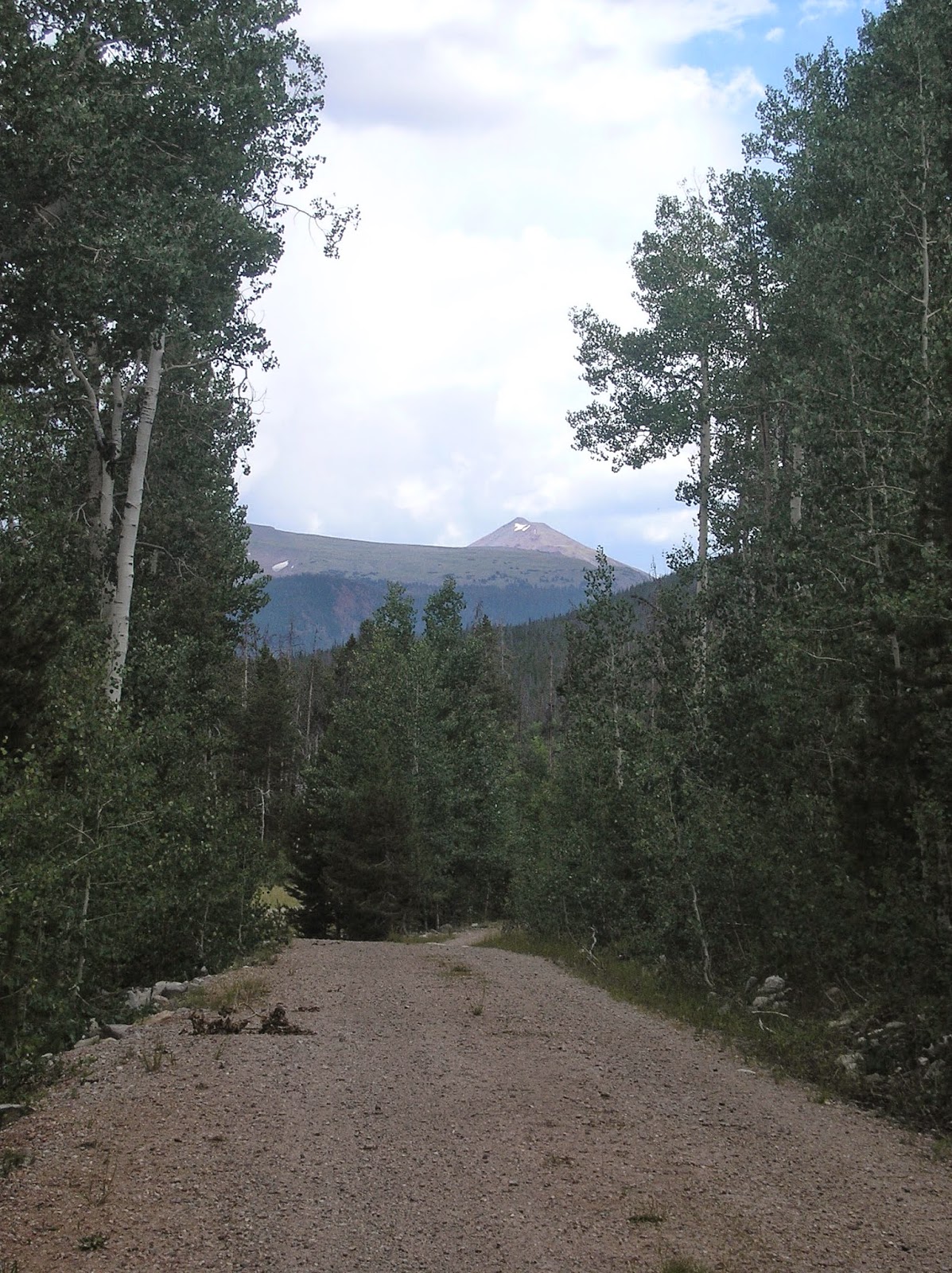Eventually I'll move on. I have very strong desires to backpack, say, the Teton Crest Trail, see the major sites in the Wind Rivers, do the Maroon Bells/Snowmass Loop in the Elk Mountains, go back to the San Juans (which I also saw as a teenager), hike in the Gros Ventre, Idaho Sawtooth Mountains and the Montana Beartooth Mountains, and many more besides. I've also got wildly enthusiastic desires to do some other hikes at seasons that aren't compatible with "mountain hiking" season; the Chisos Mountains and other locations in Big Bend National Park, the Guadalupe Mountains, the Grand Canyon, Canyons of the Escalante area, Zion National Park, the Patagonian Andes, the Southern Alps, the Blue Ridge Mountains, etc. But for 2015, it seems likely that my efforts will again be in the Uintas.
I tossed around a few itinerary ideas a few days ago, but my ideas have since evolved a bit. It's early, obviously, so they may change yet again--many times, even--and they may end up even being adapted on the fly, since I certainly learned last summer that that's a totally doable option.
While I'm at it, I'm including an itinerary for a putative third trip to the Uintas, maybe with my next son, who'll be old enough a little bit down the road. I think concentrating my western end of the Uintas into South and North of the main ridge is a smart strategy; while my central/eastern Uintas is pretty much just coming down from the north (the southern approaches are very long.) And I may yet, one of these days, through-hike the entire Uinta Highline Trail. If I do so, it'll be on yet another separate trip, and it's debatable which starting point I'll pick; the Chepeta Lake one (the shortest) which concentrates on the High Uinta Wilderness Area and is the nearest trailhead that allows you to traverse the entire wilderness, the Hacking No 1 Lake in the shadow of Leidy Peak, which is longer, and which is completely contained on one Trails Illustrated map, or the actual beginning of the trail at Hwy 191 north of Vernal. The eastern High Bollies part of the Uintas is on a separate map, I hear it requires some route-finding and dodgy trail conditions, and lacks much of the scenic drama that comes to the west and central parts of the range, so many hikers clip it in the interest of getting more bang for their hiking buck. There are other options too, I suppose; but those are the three main options. I'm currently leaning towards the middle one if I can pull it off. But that's a discussion for another day.
For the 2015 trip, my itinerary would look like this:
- Arrive on the Mirror Lake Highway around mid-day of the first day. Have reservations already in place for a campsite at, maybe, Moosehorn camping area (or Mirror Lake itself if available.) Set up tent and climb to the trailed summit of Bald Mountain. Come back down and spend the evening in camp.
- Spend another full day hiking out to Notch Mountain (not to be confused with Notch Peak, which is in a totally different area of Utah), doing a loop which allows me to hike through the actual notch. Maybe summit East (or West) Notch. Keep in mind, that while I like a few summits, I don't want to get into the trap of feeling like summiting is the whole reason that I'm going. That strikes me as a kind of metrics driven, joyless experience that I want to avoid, and is in fact one of the main reasons I want to get into the wilderness in the first place is to avoid that very attitude. But a few peaks here and there is fun, a nice accomplishment, and something that I want to share with my kids. After this, spend the night in the same camp again.
- Break camp early and set out from the Highline Trailhead, making for Naturalist Basin. Shouldn't have any trouble getting to either Blue Lake or Faxon Lake before it's too late, and then have plenty of time to explore the basin in the afternoon/evening after camp is established. Again; peak-bagging? Aggasiz and Spread Eagle are right there. Could do one, but not likely that I'd do both; certainly not on the afternoon in which I arrive in the area. I do want to thoroughly explore the upper bench, however, and the ridge that separates Naturalist from Middle Basin. This will likely take a day and a half, so my plan is to spend two nights in the same campsite, and not rush myself the first afternoon that I arrive, expecting to do too much in one day. By the way, between this more thorough exploration of the area and the more brusque exploration I had last year, I'll probably have seen enough of Naturalist that I'm ready to explore other areas from this point on and leave Naturalist alone after that. Unless I have some unforeseen opportunity to take someone else there that really wants to see it, of course.
- After two nights in Naturalist, I'll break camp early, head back to the Highline Trail, and rather than heading back west to the trailhead and my car, head east to Rocky Sea Pass. Following (more or less) the itinerary of Peter Potterfield from Classic Hikes of North America, I'd then spend two nights in Rock Creek Basin, exploring what I can of that enormous and less trammeled area.
- I've now spent six nights out, and should be close to wrapping up. If I can swing one more destination out of the trip, I'd head back early the next morning to the car and get to the East Fork Blacks Fork trailhead, where I can do one more rather ambitious loop. Taking the Bald Mountain trail (no relation to the other Bald Mountain mentioned on day 1) I'd see if, depending on how long it takes me to get back to the car and get my car to the new trailhead, I can make it all the way to the Red Castle area for the next night, where I'd set up camp by one of the three Red Castle Lakes. Most likely I'd stay on the trail, but there's also an interesting possibility of doing a significant ridge walk from Bald Mountain's summit all the way to "Squaw Mountain", i.e. Peak 12,990, and from there down to Upper Red Castle Lake to set up camp. Of course, ridge walks are a bit iffy, especially when you're trying to do them in the afternoon, when the weather in the Rockies can turn nasty, so I also have the option of sticking to the trail if it feels smarter.
- From Upper Red Castle Lake, there's an off-trail route (or perhaps an old trail that's fallen into disuse) that allows you to cross a lowish pass and end up just to the west of Porcupine Pass, where you can rejoin the Highline Trail. From here, an above treeline hike of several miles past Lambert Meadows and Mount Lovenia takes you to Red Knob Pass. This gives me the opportunity to turn onto Trail 102, the East Fork Black Forks Trail. But I'd probably want to set up camp one more time before getting too far along this trail, and then early the next morning, climb up to "Wasatch Benchmark", or Peak 13,156 and gaze the the wonder of Tokewanna. There's another ridge walk potential here; from "Wasatch Benchmark" I can continue on the ridge to "Northwest Wasatch" (13,039) and on to Tokewanna itself, where there's a gentle northeast ridge that heads back down towards the trail. This avoids prolonged hiking in the trees where I can't see anything. I could also, of course, go up the ridge of "Wasatch BM" a ways, take a good look at the scenery from that vantage point, and then just come back down and bushwhack through the open meadow slash alpine tundra that rings the ridge rather than heading lower into the trees. Either way, by the end of this day, I'm back at my car and heading towards Vernal, my backpacking experience behind me.
If all of this were to pan out, that ends up being two nights in the Bald Mountain area, two nights in Naturalist, two nights in Rock Creek and two nights on the final loop. Do I really have eight nights to spend? Not sure. That's a long trip. And as I discovered last summer, I might get tired of it before I spend that much time, especially if I'm not sleeping well, not having good weather, or otherwise just get done before I'm done. If that ends up being the case, I'd rather cut the Rock Creek stuff out instead of the last leg, but of course, we'll see what ends up happening. Lots of variables could conspire to change my plan. A perhaps better (although optimistic) way to shorten the trip by a day or two is if I have a good day when I arrive in Naturalist and see more of it than I expected, I can leave the next day. I could also cut Rock Creek Basin short, spend a day and half in it, and then start hiking back, making camp at Scudder Lake just a mile or two from the trailhead. This would also make it much easier to get an early enough start to the last leg of my trip that I can actually hope to maybe do the ridge walk and get to the Red Castle area before it's too late. But I might feel rushed in Naturalist and Rock Creek. I'd have to play that by ear.
For fun, here's an image I got on GIS of Tokewanna from, it appears, the summit of "Wasatch Benchmark."
What a clear sky!
My next completely separate trip would be a "northern basins" feature, and would have me (potentially) going back to Hell Hole and getting, if not to the summits of Kletting and/or A-1, then at least up in the saddle between them, as well as Middle Basin, and Allsop Lake, probably by making that one a loop and crossing over to Priord Lake for the way back. If I still have time after that, I'd do my long-delayed Henry's Fork Basin trip as a finisher for that trip, and see about the summit of King's Peak, the highest in Utah.
This all still leaves me plenty to do in the Uintas. But by the time I've done both of these big trips (or broken them up into components and rearranged them, if it comes to that) I'll probably be anxious to do something else and see somewhere else anyway. Wyoming, Montana, Idaho and Colorado all have destinations that call as loudly as Utah, and some day I've got lots to see in California, Oregon and Washington too.


















































